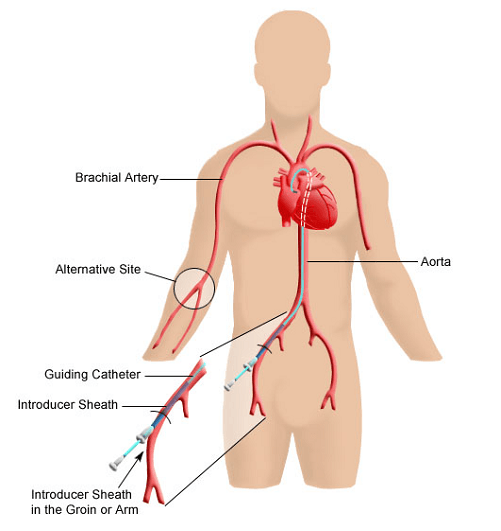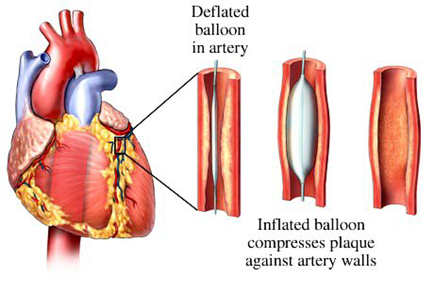Interventional Cardiology Services
City skyline
image used with permission from Medtronic
CARDIAC CATHETERIZATION
A cardiac catheterization is a procedure that helps the doctor determine if there are blockages in the blood supply that leads to the heart. A long, thin, flexible tube called a catheter is put into a blood vessel usually in your groin (upper thigh), or your arm. The catheter is guided to the heart where a small amount of dye is inserted to show the blood flow through the arteries of the heart. During the procedure, you are awake but are given medicine to help you relax. You may feel a warm, flushed feeling when the dye is injected. Once the dye reaches your heart, it will make the inside of your heart’s arteries show up on an x ray called an angiogram. Another name for this test is coronary angiography.
CORONARY ANGIOPLASTY
Percutaneous Transluminal Coronary Angioplasty is a technique used to widen a narrowing in your artery without surgery. The basic idea of angioplasty is to position a catheter with a small inflatable balloon on the end within the narrowed section of the artery. Inflation of the balloon catheter causes the balloon to push outward against the narrowing and surrounding wall of the artery. This process reduces the narrowing until it no longer interferes with blood flow. The balloon is then deflated and removed from the artery.
City skyline
image used with permission from Medtronic
City skyline
image used with permission from Medtronic
CORONARY STENTING
Many patients who have angioplasty also have stent implantation. A stent is a small, latticed, metal scaffold that is introduced into your blood vessel on a balloon catheter. The doctor will decide whether to choose a metallic stent of a drug eluting stent, depending on the location and condition of the narrowing in your coronary artery. The doctor maneuvers the catheter into the blocked artery and inflates the balloon. The stent expands against the vessel wall as the balloon is inflated. Once the balloon has been deflated and withdrawn, the stent stays in place permanently, holding the blood vessel open and improving blood flow.
TRANSAORTIC VALVE IMPLANTATION
Patients who have been diagnosed with severe aortic stenosis and who are at high risk for open heart surgery may qualify to Transcatheter Aortic Valve Implantation. Severe aortic stenosis occurs when the aortic valve doesn’t open properly. With transcatheter aortic valve implantation, the artificial aortic heart valve is attached to a wire frame and guided by a catheter (thin,flexible tube) through an artery from the groin area to the heart. Once in the proper position in the heart, the wire frame expands, allowing the new aortic valve to open and begin to pump blood.



